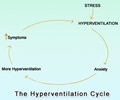Congestive heart failure kills 53,800 people and costs the nation nearly $28 billion a year in health care expenses, show data from the American Heart Association .
Congestive heart failure kills 53,800 people and costs the nation nearly $28 billion a year in health care expenses, shows data from the American Heart Association.
Congestive heart failure can cause fluid buildup in the lungs, leading to one of the most dire respiratory emergencies: severe pulmonary edema.Because the heart has been weakened by disease, blood does not flow through the lungs with normal force. As a result, something as common as eating too much salt can cause plasma to seep into the tiny sacs of the lungs where air is exchanged. Patients feel as if they are suffocating as fluid from their blood fills their lungs.
For more than 30 years, paramedics have been saving the lives of these patients by inserting, through the vocal cords, a breathing tube about the width of a small garden hose . Then , air is pushed into the lungs with an inflatable bag. The process is called intubating. Yet, the aggressive treatment is very uncomfortable for those on the receiving end. Also, it carries the risk of dangerous infection. So a device more commonly found in the hospital is making its way into ambulances, the nation over.
The breathing device is known as CPAP -continuous positive airway pressure. The football-size device with long plastic tubing and a plastic mask is being used now by emergency crews in seven other big cities, including Miami and Boston. Another 16, including Atlanta and Philadelphia, plan to put the device in ambulances soon. This is according to this month's Journal of Emergency Medical Services (JEMS).
The device has been used by hospitals for about 15 years. More recently, it has been used in homes to help people with sleep apnea get a full night's rest. An ambulance CPAP costs about $900.
Heart-failure patients often try to sit up straight and labor through hours of breathing difficulty — hoping their lungs clear with time — before seeking help. Those who have had breathing tubes inserted in the past sometimes delay the call out of fear of another tube. "Intubating a conscious patient for pulmonary edema is scary for everyone involved. It's scary for the patient, and it's scary for the paramedic," avers David Persse, Houston's EMS medical director.
The CPAP device scores here as it often prevents the need for a breathing tube. This is because oxygen can be given through the breathing mask to push the fluid out of the lungs and back into the bloodstream where it belongs. "The relief is almost immediate," says James McCarthy, medical director at Memorial Hermann's emergency center. "It's incredible to see. From a health-provider standpoint, you look like a hero." Once the fluid crisis is resolved, doctors can treat the underlying causes, such as sodium or medication imbalances. Many patients can return home within a day or so.
Source-Medindia
ANN/C
 MEDINDIA
MEDINDIA
 Email
Email









